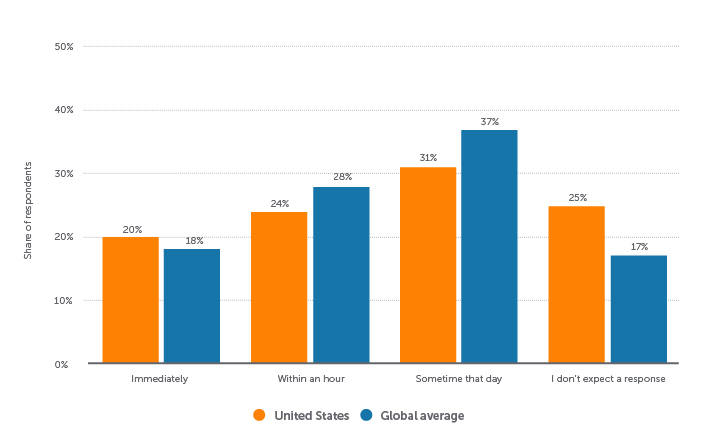6 Tips When Implementing Live Streaming to Improve Customer Support and Engagement

Throughout the past decade, the development of telecommunication technologies and the subsequent increase of internet bandwidth have made live streaming possible.
On top of this, and due to the implementation of data compression and optical fiber connectivity, live video internet traffic has risen significantly. Nowadays, what was once seen as a novelty has become a mainstream trend.
This new form of content creation and media consumption has shaped the entertainment industry, and the rise of live streaming services like Twitch is proof of this.
According to Statista, over a quarter of internet users worldwide spent more than 10 hours a day looking at videos on the web during 2020. These incredible numbers are directly related to the COVID-19 pandemic, which has forced people to stay at home.
Due to self-isolation measures, many web surfers turned to live streaming as their main form of distraction.
However, live streaming has not only revolutionized the entertainment industry. Many companies are using this technology to develop new channels of communication with their clients too. Thanks to live streaming, e-commerce companies have managed to stay in touch with customers and create new forms of engagement with their potential clients during these unprecedented times.
As a result, a new form of online shopping has started to gain notability: live commerce. This trend is the result of combining classical e-commerce practices with live streaming — and it very well may be the future of online shopping.

Although e-commerce had already transformed the retail industry — making many companies shift towards a “storeless” approach — the implementation of live streaming has rapidly made a huge impression in many sectors. Online banking, telehealth, and digital fitness are examples of internet-based services and digital industries that have been reshaped by the implementation of live streaming technology.
The digital fitness market, for example, has significantly risen during the COVID-19 pandemic. Due to social distancing measures, many gym members have been forced to change their group sessions for streaming classes.
As you can see, streaming technology is rapidly changing digital businesses. Whether you sell products online or offer internet-based services like telehealth or online banking, you might want to take note of these tips. Here are just six of the many ways to improve customer support through live streaming.
1. Get Your Setup Ready
You’ll want to make sure you have the equipment needed before starting any type of live streaming service. To offer a quality streaming experience, you’ll need a proper setup that includes HD resolution cams, high-quality mics, and software programs like Wirecast or OBS Studio.
Although investing in proper streaming gear might seem pricey, it’s important to note that these types of investments end up paying dividends in the long run. Having a professional look during your live streaming customer support is vital, especially for companies in the B2B industry.
2. Adjust to Your Budget
Whether your staff is composed of doctors, bank tellers, or your classic customer service and sales experts, providing your employees with the proper tools is vital. However, many companies will lack a sufficiently large budget to invest in a state-of-the-art streaming setup.
Luckily, smaller businesses that want to improve customer support with live streaming services can avoid investing in costly equipment by opting for simpler options like high-quality laptops that can do the trick nearly as well as professional cameras. Technologies like WebRTC make it easy to stream from your browser to the world without the need for an encoder or complex infrastructure.
Additionally, companies with more modest budgets can opt for free video conferencing software programs instead of expensive apps. After a while, as these video streaming practices become business as usual, you can decide whether to make the jump and upgrade according to your budget.

3. Train Your Staff
Since practices like live commerce and streaming customer service are fairly new to most business owners, the role of streaming vendors is not very well understood. Consequently, some staff members might need to learn new skills in order to adapt to this trend.
Remember, not everybody is ready to work live in front of a camera. In business sectors like the IT industry, sometimes the most skilled technicians might not be prepared to deal with frustrated clients.
By training your customer support team to lead this new form of client service, you will avoid those awkward silences and dreaded “Is this live?” moments. Some streaming vendors even offer professional services for non-video experts who want to get up and running quickly.
4. Have a Well-Organized Customer Service Team
Contrary to what many companies believe, the customer support department is more than an isolated area of your business. A well-organized client service team usually consists of experts from different departments: sales, marketing, IT, HR, etc.
Due to the heterogeneous nature of customer service, team integration and collaboration are vital to offering excellent customer support. Although the services provided by live streaming communication channels are usually used to connect vendors and clients, employees can use them too.
Implementing employee communication tools can help companies develop stronger customer service teams. These apps include essential features like video chats, instant messaging, and file management — tools designed to help client service teams work faster and more efficiently.
Regarding file management, providing your team with the best file sharing app can help your staff understand each incident better. These tools are especially useful for subscription-based businesses since these types of companies usually have different files for each client.

5. Listen to Your Customers
Asking for feedback is one of the milestones of customer service. Companies looking to improve client support usually turn to their buyers when looking for honest reviews.
Another way to know your clientele better is by implementing e-commerce analytics. These user-focused data can help businesses understand their buyers’ habits, needs, and preferences better. Although these practices seem to only fit online shopping companies, in reality, client analytics can be implemented by any business. Companies offering telehealth services, for example, can measure satisfaction rates by simply asking their clients to fill some questionnaires and send reviews.
Statistics can give you a rough idea of what your clients want and need. Quantitative data is helpful on its own, but qualitative intel can help you understand those numbers better.
To do so, you can complement analytics by simply adding probing questions for sales in your reviews and surveys. These questions will add more detail to your customers’ responses and will help you understand them better.
However, you might be wondering: “How does live streaming fit into that narrative?” Well, you can create ‘town-hall style’ live meetings for your customers. These live events allow your clients to share their inquiries and frustrations.
Gathering all that information and building customer service strategies around them will help you develop a stronger client support department.
Another tool that can help you implement live streaming into this strategy is organizing AMA (ask me anything) sessions between you and your clients. Imagine what a conversation between Tesla users and Elon Musk would look like. Well, you don’t have to imagine it, because Musk himself has done it (you can check it out here).
6. Improve Your Social Media Presence
Nowadays, in the digital era we’re currently living through, companies cannot underestimate the power of social media as a marketing and customer service tool.
Although many smaller businesses might feel inclined to think that only big corporations are affected by bad reviews or negative comments posted on social media, the data proves otherwise.
According to Statista, almost half of online shoppers in the United States consider public customer reviews and user-generated content on social media as an essential reference point during online purchases.
As a result, influencer streaming has become one of the most popular types of live commerce in the digital era. Influencer streaming offers an interactive format of advertising that resonates especially well with Gen Zs — converting younger demographics faster than more classic forms of advertising and selling.
Additionally, 39% of online buyers think that customer reviews are more important than content generated by the companies themselves.

The same study also states that over 40% of online shoppers feel encouraged to interact with brands that are active on social media.
As evidenced by these numbers, having an active and engaging social media presence is essential when developing a strong customer engagement strategy.
In the current social media era, professional advertisers and marketers are starting to be replaced by streamers and influencers. The current stars of Instagram, Twitch, or YouTube hold the keys to the social media kingdom.
You would be wrong to think that influencers online operate only in the fashion or fitness industries. For any type of content you can think of, there will be a community created around it: legal advising, trading, marketing — there are no limits to what the internet is capable of.
Being active on social media is not enough. Companies willing to invest in social media as a customer service tool must take this outlet seriously. According to Statista, almost a fourth of online shoppers that contact brands via social media expect a reply within the first hour. Additionally, over a third of social media users expect their complaints to be heard and replied to within the same day.
What is your expected response time for social media questions or complaints?

Although this data is essential for companies looking to use social media as a customer support tool, being on top of your mentions and DMs is not the only course of action that you can take to communicate with your clients. There are many other ways to leverage social media, too, including:
- Creating live events like contests and giveaways.
- Focusing on the ‘social’ side of social media to create a sense of community around your brand.
- Live streaming company events.
To make strategies like these work, you must successfully integrate marketing collaboration tools that can help advertisers work together and develop more robust advertising campaigns.
Remember, marketing campaigns are not only launched to boost engagement and turn leads into customers; they can help you with customer retention, too.
Follow these six top tips today to develop a strong relationship with your customers, and you can ensure that your client support won’t be matched by your competitors.




